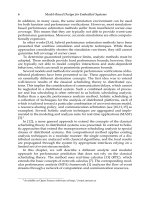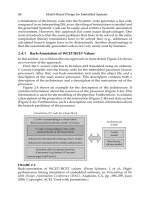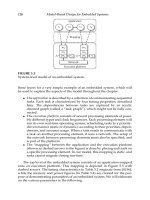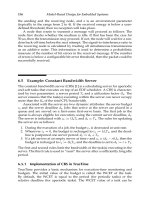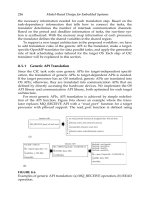Model-Based Design for Embedded Systems- P14 pptx
Bạn đang xem bản rút gọn của tài liệu. Xem và tải ngay bản đầy đủ của tài liệu tại đây (441.6 KB, 10 trang )
Nicolescu/Model-Based Design for Embedded Systems 67842_C004 Finals Page 96 2009-9-30
96 Model-Based Design for Embedded Systems
extended with integer variables and richer user-defined data types. A timed
automaton is a finite-state machine, extended with clock variables. The tool
uses a dense time-model of time, so clock variables evaluate to real numbers.
All the clocks progress synchronously.
We use, in this section, the train-gate example (distributed with the tool).
It is a railway system that controls, access to a bridge. The bridge has only
one track, and a gate controller ensures that at most one approaching train
is granted access to this track. Stopping and restarting a train takes time.
Figure 4.1 shows the model of a train in the editor of U
PPAAL. When a train
is approaching (Appr), it must be stopped before 10 time units, otherwise, it
is too late and the train must cross the bridge (Cross). When it is stopped
(Stop), it must be restarted (Start) before crossing the bridge.
The timing constraints associated with the locations are “invariants.”
They give a bound on how long these locations can be active: A train can
stay in Appr at most 20 time units and then must leave this location. Edges
between locations have guards (x<=10) to constrain when they can be taken,
synchronizations (stop[id]?) for communication, and updates (x=0)to
reset the clock x. Automata communicate with each other by means of chan-
nels. Here, we have an array of channels and every train has its own id. The
gate automaton selects a train and synchronizes with it with stop[id]!.In
U
PPAAL, it is possible to declare arrays of clocks or any other type. Channels
can be declared to be “urgent” to prevent delays if a synchronization is pos-
sible, or “broadcast” to achieve broadcast synchronization instead of hand-
shake. Listing 4.1 shows the global declaration of the model with the channel
FIGURE 4.1
View of the train template in the editor.
Nicolescu/Model-Based Design for Embedded Systems 67842_C004 Finals Page 97 2009-9-30
Model-Based Framework for Schedulability Analysis Using UPPAAL 4.1 97
Listing 4.1 Global declarations for the train-gate model.
1 const int N = 6; // Number of trains
2 typedef int [0,N−1] id_t;
3 chan appr[N], stop[N], leave[N];
4 urgent chan go[N];
declarations. A constant is declared to size the model to the desired num-
ber of trains. The train model here is in fact a “template” for trains. Trains
are instantiated with a given id. In this case, having in the system decla-
ration system Gate, Train; will instantiate an automaton for the Gate
controller and all the possible trains ranging over their missing argument
types. This is the “auto-instantiation” feature. It is possible to give specific
argument values too. The type id_t is a user-defined type declared in List-
ing 4.1. U
PPAAL supports more complex user-defined types such as structures.
It is possible to combine arrays, structures, bounded integers, channels, and
clocks.
Figure 4.2 shows the simulator with the Gate automaton. On the mes-
sage sequence chart, the different synchronizations between the automata
are shown. The automaton has two main locations where the bridge is free
or occupied. When a train is approaching it synchronizes with the gate, and
with a function call it is queued by the gate. If more trains are approaching,
then they are queued and stopped. Queuing followed by stopping is atomic,
FIGURE 4.2
View of a simulation of the train-gate model showing the gate and one train.
Nicolescu/Model-Based Design for Embedded Systems 67842_C004 Finals Page 98 2009-9-30
98 Model-Based Design for Embedded Systems
Listing 4.2 Local declarations of the Gate template.
1 id_t list [N+1];
2 int [0,N] len;
3
4
void enqueue(id_t element) // Put an element at the end of the queue
5 {
6 list [len++] = element;
7 }
8
9
void dequeue() // Remove the front element of the queue
10 {
11 int i = 0;
12 len −=1;
13 while (i <len)
14 {
15 list [i ] = list [i + 1];
16 i++;
17 }
18 list [i ] = 0;
19 }
20
21
id_t front () // Returns the front element of the queue
22 {
23 return list [0];
24 }
25
26
id_t tail () // Returns the last element of the queue
27 {
28 return list [len − 1];
29 }
which is modeled by marking the location “committed.” Such a location for-
bids interleaving with other automata when it is active. A location can be
marked “urgent” to mean that time cannot be delayed while it is active. After
this, the gate dequeues a train and leaves it to cross the bridge. After that it
will try to dequeue more trains and restart them with go[front()]!. Here,
a function call is used to return the front of the queue. The Gate “picks” a
train with the “select” statement, e:id_t. This allows the modeler to scale
the model with the number of trains while still keeping the automaton com-
pact. Listing 4.2 gives the complete local declarations of the Gate automaton.
U
PPAAL supports a C-like syntax that allows us to implement a queue here.
One of the locations of the gate is marked “C.”
Another feature of the language is the “scalar” type to define scalar sets.
When these sets are used, the model checker takes advantage of their sym-
metries. Different variants of U
PPAAL exist in other specific problem domains.
Nicolescu/Model-Based Design for Embedded Systems 67842_C004 Finals Page 99 2009-9-30
Model-Based Framework for Schedulability Analysis Using UPPAAL 4.1 99
U
PPAAL-TIGA [6,18] is based on timed game automata and is targeted toward
code synthesis. U
PPAAL-CORA [7,29] is designed for cost-optimal reachability
analysis. U
PPAAL-PRO [12,28] extends timed automata with probabilities.
Further features of U
PPAAL include meta-variables, which can be used
to store values such as regular variables; however, meta-variables are not
included in the state inclusion check when doing model checking. That is,
two states are considered identical if all but the meta-variables agree. Meta-
variables are declared using the “meta” keyword (meta int i).
Finally, U
PPAAL (as of version 4.1) supports stopwatches. Stopwatches are
like clock variables; however, the progress of stopwatches can be set to either
zero or one in automata locations, which is specified as an invariant (x
== 0
for clock x). When analyzing models using stopwatches, U
PPAAL computes
a finite overapproximation of the state space and is, thus, guaranteed to ter-
minate even though the model-checking problem for stopwatch automata is,
in general, undecidable. Checking properties such as avoidance of deadlocks
can be meaningful for stopwatch automata, since if the overapproximation
does not have a deadlock then neither will the real system. In Section 4.4,
stopwatches are used to model preemptive schedulability problems using
U
PPAAL.
4.2.2 Specification Language
The specification language of UPPAAL is a subset of the timed computation
tree logic (TCTL) [1]. The following properties are supported: (1) A[] φ,(2)
E<> φ,(3)A<> φ,(4)E[] φ,and(5)φ−− > ψ, where φ and ψ are state pred-
icates. The safety property (1) specifies that φ must be satisfied for all states.
The reachability property (2) specifies that there exists a path on which a
state satisfies φ. The reachability property (3) specifies that for all paths there
must be a state that satisfies φ. The liveness property (4) specifies that there
is a path on which all states satisfy φ. The “leads-to” property (5) specifies
that whenever a state satisfying φ is reached, then for all subsequent paths
a state satisfying ψ is reached. In addition, U
PPAAL can check for deadlocks
with the property A[] not deadlock.
4.3 Schedulability Problems
At the core of any schedulability problem are the notions of tasks and
resources. Tasks are jobs that require the usage of resources for a given
duration after which tasks are considered done/completed. The added con-
straints to this basic setup is what defines a specific schedulability problem.
In this section, we define a range of classical schedulability problems.
Nicolescu/Model-Based Design for Embedded Systems 67842_C004 Finals Page 100 2009-9-30
100 Model-Based Design for Embedded Systems
4.3.1 Tasks
A schedulability problem always consists of a finite set of tasks, which we
consistently will refer to as T = t
1
, t
2
, ,t
n
. Each task has a number of
attributes that we refer to by the following functions:
•
INITIAL_OFFSET: T → N
Time offset for initial release of task.
•
BCET: T → N
≥0
Best case execution time of task.
•
WCET: T → N
≥0
Worst case execution time of task.
•
MIN_PERIOD: T → N
Minimum time between task releases.
•
MAX_PERIOD: T → N
Maximum time between task releases.
•
OFFSET: The time offset into every period, before the task is released.
•
DEADLINE: T → N
≥0
The number of time units within which a task must finish execution
after its release. Often, the deadline coincides with the period.
•
PRIORITY: Task priority.
These attributes are subject to the obvious constraints that
BCET(t) ≤ WCET
(t) ≤ DEADLINE(t) ≤ MIN_PERIOD(t) ≤ MAX_PERIOD(t). The periods are ignored if
the task is nonperiodic.
The interpretation of these attributes is that a given task t
i
cannot execute
for the first
OFFSET (t
i
) time units, and should hereafter execute exactly once in
every period of
PERIOD (t
i
) time units. Each such execution has a duration in
the interval [
BCET (t
i
),WCET (t
i
)]. The reason why tasks have a duration inter-
val instead of a specific duration is that tasks are often complex operations
that need to be executed, and the specific computation of a task depends on
conditionals, loops, etc. and can vary between invocations. Furthermore, for
multiprocessor scheduling, considering only worst-case execution times is
insufficient as deadline violations can result from certain tasks exhibiting the
best-case behavior.
We say that a task t is “ready” (to execute) at time τ iff
1. τ ≥
INITIAL_OFFSET(t).
2. t has not executed in the given period dictated by τ.
3. All other constraints on t are satisfied. (Refer Section 4.3.2 for a discus-
sion on task constraints.)
4.3.2 Task Dependencies
Task execution is often not just constrained by periods, but also by inter-
dependencies among tasks, for example, because one task requires data
that is computed by other tasks. Such dependencies among a set of tasks,
Nicolescu/Model-Based Design for Embedded Systems 67842_C004 Finals Page 101 2009-9-30
Model-Based Framework for Schedulability Analysis Using UPPAAL 4.1 101
T = t
1
, t
2
, ,t
n
, are modeled as a directed acyclic graph (V,E), where tasks
are nodes (i.e., V = T) and dependencies are directed edges between nodes.
That is, an edge (t
i
, t
j
) ∈ E from task t
i
to task t
j
indicates that task t
j
cannot
begin execution until task t
i
has completed execution.
4.3.3 Resources
Resources are the elements that execute tasks. Each resource uses a scheduler
to determine which task gets executed on a given resource at any point in
time. Resources are limited by allowing the execution of only a single task at
any given time.
Tasks are assigned a priori to resources. For a set of resources, R =
r
1
, ,r
k
, and a set of tasks, T = t
1
, ,t
n
, we capture with the function ASSIGN :
T → R.
In a real-time system, resources function as different types of processors,
communication busses, etc. Combined with task graphs we can use tasks and
resources to emulate complex systems with such task interdependencies on
different processors. For example, if we want tomodel two tasks t
i
and t
j
with
dependency t
i
→ t
j
, but the tasks are executed on different processors and t
j
needs the results of t
i
to be communicated across a data bus, we introduce an
auxiliary task t
ic
that requires the bus resource and update the dependencies
to t
i
→ t
ic
→ t
j
. We illustrate this concept in Figure 4.8.
4.3.3.1 Scheduling Policies
In order for a resource to determine which task to execute and which tasks
to hold, the resource applies a certain scheduling policy implemented in a
scheduler. Scheduling strategies vary greatly in complexity depending on
the constraints of the schedulability problem. In this section, we discuss a
subset of scheduling policies for which we have included models in our
scheduling framework.
• First-In First-Out Ready tasks are added to a queue in the order they
become ready.
• Earliest Deadline First Ready tasks are added to a sorted list and exe-
cuted in the order of the earliest deadline.
• Fixed Priority Scheduling Each task is given an extra attribute,
PRIOR-
ITY
, and ready tasks are executed according to the highest PRIORITY.
Schedulers operate in such a manner that resources are never idle while
there are ready tasks assigned to them. That is, as soon a task has finished
execution a new task is set for execution.
4.3.3.2 Preemption
Resources come in two shapes: preemptive and nonpreemptive. A nonpre-
emptive resource means that once a task has been assigned to execute on
Nicolescu/Model-Based Design for Embedded Systems 67842_C004 Finals Page 102 2009-9-30
102 Model-Based Design for Embedded Systems
a given resource, that task will run until completion before another task is
assigned to the resource. Preemption means that a task assigned to a resource
can be temporarily halted from execution if the scheduler decides to assign
another task to the resource. We say that the first task has been preempted.
A preempted task can later resume execution for the remaining part of its
duration.
Preemption allows for a greater responsiveness to tasks that are close to
missing their deadline, but that flexibility is on behalf of the increased com-
plexity of the schedulability analysis. The framework we define in the follow-
ing section will include a model for schedulability analysis with preemption.
4.3.4 Schedulability
Now, we define what it means for a system to be schedulable. A system of
tasks with constraints and resources with scheduling policies is said to be
schedulable if no execution satisfying the constraints of the system violates a
deadline.
4.4 Framework Model in UPPAAL
In this section, we will describe our UPPAAL framework for analyzing the
scheduling problems defined in Section 4.3. The framework is constructed
such that a model of a particular scheduling problem consists of three dif-
ferent timed automata templates: a generic task template, a generic resource
template, and a scheduling policy model for each applied policy. We will
describe the templates in this order.
4.4.1 Modeling Idea
In order to best explain the framework models, we will provide an abstract
scheduling model that will serve as a base for the framework models. The
abstract scheduling model is based on the basic scheduling model defined
in [7].
The model depicted in Figure 4.3 naturally divides the scheduling prob-
lem into tasks (Figure 4.3a) and resources (Figure 4.3b). Each task and
resource has a unique identifier (id). Initially, tasks are Waiting, and when
a task is ready to execute, this is signaled to the resource to which the
task is assigned, using the channel “ready,” indexed with the appropriate
resource id (i.e., the variable resource). This moves the task to Ready where
it remains until either the deadline has passed, in which case the task moves
to Error, or it receives a signal that the execution is complete via the channel
“finished” indexed with the task id, in which case the task moves to Done.
Nicolescu/Model-Based Design for Embedded Systems 67842_C004 Finals Page 103 2009-9-30
Model-Based Framework for Schedulability Analysis Using UPPAAL 4.1 103
Error
(a)
Done
Ready
Waiting
Time > = Deadline
finished[id]?
ready[resource]!
InUse
x <= UseTime(b)
Idle
x == UseTime
finished[task]!
ready[id]?
x=0
FIGURE 4.3
Abstract task and resource models. (a) Abstract task automaton and (b)
abstract resource automaton.
Resources have two locations Idle and InUse indicating the state of the
resource. Resources move from Idle to InUse upon a “ready” signal from
a task, and return to Idle after the appropriate execution time. Resources
signal that the task has finished execution using “finish,” indexed with the
appropriate task.
With this model, schedulability can be verified with the following CTL
query:
A[] forall(i : task_id) not Task(i).Error
That is, is it always the case that on all execution paths no task will ever be
in the Error location?
This is the base of the framework model introduced in the following
sections. The added complexity of these models is because of the handling
of preemption, periods, and different scheduling policies. Before introduc-
ing the models, we will introduce some of the basic data structures used in
the code.
4.4.2 Data Structures
For each scheduling problem with tasks T = t
0
, , t
n
and resources R =
r
0
, , r
k
, we define the following data types for convenience:
t_id: Task ids ranging from 0 to n
r_id: Resource ids ranging from 0 to k
time_t: Integer value between zero and the largest period among all tasks
Having established the above data types we can move to more complex
data types such as the data structure representing a task, which is called
task_t and is depicted in Listing 4.3. In other words, the data structure of the
task holds all task attributes defined in Section 4.3.1. Note that the “priority”
is given by pri as ‘priority’ is a reserved keyword in U
PPAAL.
Nicolescu/Model-Based Design for Embedded Systems 67842_C004 Finals Page 104 2009-9-30
104 Model-Based Design for Embedded Systems
Listing 4.3 Task structure.
1 typedef struct {
2 time_t initial_offset ;
3 time_t min_period;
4 time_t max_period;
5 time_t offset ;
6 time_t deadline;
7 time_t bcet;
8 time_t wcet;
9 r_id resource;
10 int pri ;
11 } task_t ;
Listing 4.4 Resource buffer.
1 typedef struct {
2 int [0,Tasks] length;
3 t_id element[Tasks];
4 } buffer_t ;
To specify a set of tasks, we create a global array called task of type task_t
with one entry per task. The index of the array is the unique task identifier.
See Section 4.5 for an example of task instantiation.
The final data structure is buffer_t which, is the central data structure of
the resource template. Each resource has a buffer that keeps track of the tasks
ready to execute on a given resource and is sorted according to the respec-
tive scheduling policy. The buffer element is defined in Listing 4.4. Resource
buffers are held in a global array called buffer with one index per resource.
The above data structures serve as the foundation of the template models
defined in the following sections.
4.4.3 Task Template
The task template serves as a model for both periodic and nonperiodic tasks.
The type of scheduling problem at hand is specified using the global Boolean
parameter Periodic. This variable is tested in the task template to guarantee
that tasks observe correct periodic or nonperiodic behaviors.
The task template, depicted in Figure 4.4, takes a single parameter,
namely, the task id, which is used to index the task array. The basic struc-
ture of a task consists of five locations named,
• Initial (initial): The task is waiting for the initial offset time to
elapse.
• Waiting: The task is waiting for certain conditions in order to be ready
to execute. This location is actually split into two locations representing
whether the task is waiting for the period offset to have elapsed or
Nicolescu/Model-Based Design for Embedded Systems 67842_C004 Finals Page 105 2009-9-30
Model-Based Framework for Schedulability Analysis Using UPPAAL 4.1 105
ready_task = id
completed ()
finished [id]!
ready [resource ()]!
time [id] > deadline ()
time [id]= 0, x = 0,
new_period ()
x >= BCET ()
dependencies_met ()
time [id] >= MinPeriod ()
Ready
PeriodDone
WaitingOffset
x΄== 0
WaitingDepedency
Error
Done
Initial
time [id]== InitialOffset ()
x΄== 0 &&
time [id] <= MaxPeriod ()
x΄== isRunning () &&
x <= WCET ()
x΄== 0 &&
time [id] <= InitialOffset ()
x΄== 0
Periodic
C
C
x΄== 0 &&
time [id] <= offset ()
!Periodic
time [id]== offset ()
FIGURE 4.4
Task template—takes argument id of type t_id.
some other user-defined requirement. We return to the latter later in
this section.
• Ready: The task is either executing or waiting to execute in the buffer
of the respective resource.
• Error: The task did not manage to complete execution before the
deadline.
• Done: The task has successfully completed execution within its dead-
line. This location is split into two locations. Which one of the two Done
locations is used depends on whether the scheduling problem is peri-
odic or not. In case the problem is nonperiodic, the done location is
final; otherwise, the done location is a holding location waiting for the
next period.
For every task attribute, we define a local function to access that
attribute in the global task array. That is, the function resource() returns
task[id].resource, BCET() returns task[id].bcet,etc.

